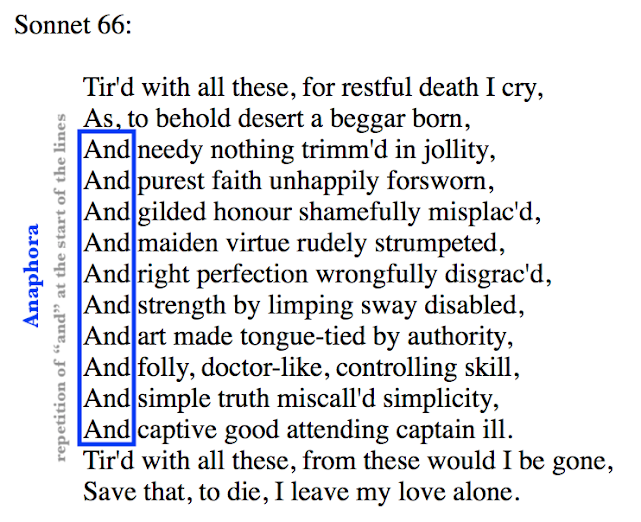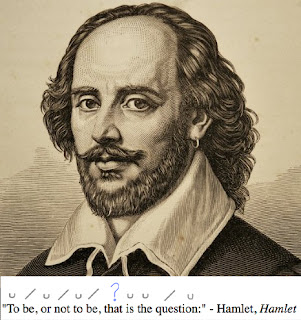An Overview of the Shakespearean Sonnet
In addition to writing plays, Shakespeare was also a greatly acclaimed poet. In 1609, the most complete volume of his poems were published under the title The Sonnets of Shakespeare. The Sonnets of Shakespeare contains 154 sonnets, all written in Shakespearean form.
Note: some poetic terms are linked to the Poetry Foundation Glossary's definition of those terms. The Green-Eyed Blogger does not receive any reward, monetary or otherwise, from link clicks––they are simply included for user convenience.
The Structure of the Shakespearean Sonnet
To understand the Shakespearean sonnet, we must first understand the sonnet itself. A sonnet is a type of poem with 14 lines and a rhyme scheme. The sonnet originated in Italy and was brought to England around the 16th Century, so the form was still relatively new when Shakespeare wrote his sonnets. Traditionally, the sonnet has a clear focus and contains a turn, or volta, which is a moment of clarification relating to that focus, towards the end of the poem. The volta is often indicated with turning point words, such as 'but,' or 'yet.'
The Shakespearean sonnet, also called the English sonnet, has a structure of three quatrains (four-line stanzas), and a concluding couplet (two rhyming lines). The rhyme scene for the Shakespearean sonnet is ABAB CDCD EFEF GG. Below is Sonnet 29, an annotated example of the structure of a Shakespearean sonnet. Shakespearean sonnets are based in iambic pentameter, like Shakespeare's blank verse, but frequently include metrical variations. For more information on understanding, unpacking, and finding meaning from Shakespeare's meter, see our blog post on scanning Shakespeare's verse.
Some Poetic Devices in Shakespeare's Sonnets
It is important to identify and understand the poetic devices in Shakespeare's sonnets to unlock their full meaning––a solid understanding of the poetic devices will lead to a richer experience from reading each sonnet.
Imagery
Imagery can be described as the use of descriptive or figurative language to engage one of the five senses, and illustrate a mental image for the reader. Many other literary and poetic devices conjure specific images in the mind of the reader––thus, as in the examples below, a metaphor or simile might also be described as an image.
The example below shows Shakespeare's imagery without the aid of other literary devices. The main words and phrases which create the images of the poem are underlined in blue.
Simile
A simile is a comparison that uses "like," "as," or "than." Similes, like the one in the example below, are often examples of imagery as well.
Metaphor
A metaphor is a comparison, direct or indirect, which points out similarity without the use of "like," "as," or "than." Since these words are indicative of similes, literary or poetic comparisons which are not similes are most often metaphors.
The example below is a direct metaphor, which compares one thing to another explicitly, usually with the verb 'to be.'
Sound Devices: Assonance, Consonance, Alliteration, and Sibilance
Shakespeare also frequently uses sound devices in his sonnets. Assonance is the presence of repeated vowel sounds in words within a phrase or verse line. Consonance is the presence of repeated consonant sounds in words within a phrase or verse line. Alliteration, a type of consonance, is the repetition of the first sound (or first stressed sound) of words. Sibilance, another type of consonance, is the repetition of 's' or 'sh' sounds in words.
In the example below, assonance is underline in pink, consonance in blue, alliteration in orange, and sibilance in green.
Antithesis
Antithesis is the juxtaposition of starkly contrasting words, phrases, or clauses. In his Playing Shakespeare book and TV series, John Barton describes Shakespeare's antithesis as setting the words against one another. Antitheses are essential in Shakespeare's creation of inconsistencies and ambiguities in both his plays and his poems.
The example below includes multiple examples of antithesis, each underlined in their own color.
Anaphora
Anaphora is the repetition of a word or words at the beginning of successive phrases, sentences, or verse lines.
To Whom were Shakespeare's Sonnets Addressed?
Most of Shakespeare's sonnets are addressed to one of two individuals: a young man, or the 'Dark Lady.' Both addressees were a notable depart from previously written sonnets, which almost always expressed love for an idealized, goddess-like woman. This difference in content is arguably what makes Shakespeare's sonnets so unique. Yes, he talks about love––but in an unprecedented way for his time. In the example sonnets above, he talks about love and beauty in terms of wealth, aging, time, poetry, decay, and death.
Below is the most notable, clearest example of his depart from the idealization of female lovers in poetry. Each traditional comparison, which Shakespeare pushes against, is underlined in its own unique color.
Readings of Shakespeare's Sonnets
During the COVID-19 pandemic, renowned Shakespearean actor Patrick Stewart has been reading A Sonnet A Day on his Facebook page.











Comments
Post a Comment
All comments are moderated by the Green-Eyed Blogger to avoid spam. If you do not see your comment right away, do not worry; it is simply undergoing our routine moderation process.